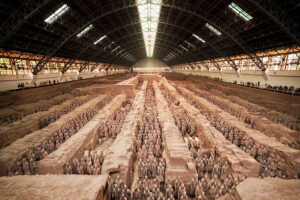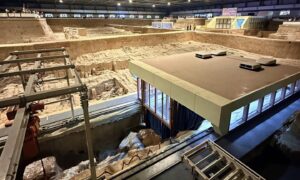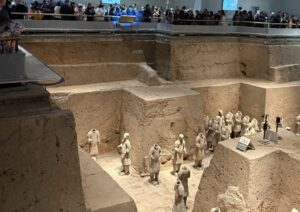Xi'an Famous Attraction Terracotta Warriors Ultimate Guide(2025)
Why the Terracotta Warriors Worth Visiting
Jacques Chirac wasn’t exaggerating when he proclaimed this archaeological marvel "the Eighth Wonder of the World." As you descend into the sprawling excavation complex near Xi’an, prepare to confront humanity’s most astonishing feat of preservation: an 8,000-strong clay battalion frozen mid-march since 210 BCE. Designated a UNESCO World Heritage Site for its "outstanding universal value," this 20,000㎡ underground citadel reveals Qin Dynasty military mastery through every meticulously crafted detail. Each life-sized warrior bears unique facial features - from subtle dimples to distinctive brow ridges - making this not just the largest terracotta warriors ever discovered, but an eerily personal encounter with China’s first emperor’s quest for immortality.
The Terracotta Pits
Pit Layout Overview
Pit 1: The Infantry Vanguard
Enter the colossal hangar-like structure sheltering the frontline troops. Here, 6,000 soldiers stand in 38 columned trenches, their once-vibrant painted armor now faded to earthy tones. Notice how vanguard units lack protective gear – sacrificial positions meant to absorb initial attacks. The scale overwhelms: rows upon rows of stern-faced conscripts stretching into shadowed depths, still guarding secrets 22 centuries after burial.

Pit 2: Ancient Special Forces
This L-shaped tactical formation showcases Qin’s military innovation. Bronze chariots drawn by terracotta stallions advance alongside three specialized units: kneeling crossbowmen (archers who fired in rotating volleys), cavalry with saddled warhorses (China’s earliest known cavalry), and armored infantry with close-combat ge dagger-axes. Peer into partially excavated trenches – ongoing work reveals soldiers still half-embedded in soil like ancient fossils.

Pit 3: Command Headquarters
The smallest yet most revealing pit exposes ancient military hierarchy. Sixty-eight elite officers stand guard around a ritual chariot painted with mythical beasts. Bronze deer horns and animal bones found here suggest divination ceremonies. Don’t miss the "Lucky General" – his intact painted eyelashes and vermilion lips offer rare glimpses of original pigments.

Notable Figures
-
Kneeling Archer (Pit 2): His coiled energy is palpable. Study the sole surviving example with original paint: crimson armor laces, emerald green cuffs, and black nail details on his tightly clenched fists.
-
Charioteer (Bronze Chariot Hall): This half-size masterpiece features a turquoise canopy with dragonfly-wing ventilation and a 2,400-link silver harness.
-
Green-Faced Warrior (Conservation Hall): Is he a shaman? A poisoned sentry? His jade-toned skin defies explanation among flesh-toned comrades.
Historical Significance
Cultural Legacy
The story behind the Terracotta Warriors is Emperor Qin Shi Huang’s obsession with eternity. Every detail reflects his standardized revolution: uniform weapon sockets prove crossbow triggers were mass-produced, while variations in shoe knots indicate regional troop origins. The clay itself is political poetry – sourced from Mount Li where legend claims the emperor’s jade heart is buried.
Unsolved Mysteries
Many about the terracotta warriors is still unknown. How did artisans achieve individualistic faces? Molded bases with hand-sculpted features explain diversity, but the soulful expressions remain haunting. More baffling: bronze swords coated with 10-15 micron chromium dioxide layers – a rust-proofing technique only replicated industrially in 20th-century Germany. When excavators tested one blade, it effortlessly sliced through 12 layers of paper.
Visiting Tips
Ticket Information
Purchase ¥120 combo tickets (Pits 1-3 + Bronze Chariots) via *Trip.com*’s English portal. Summer/holidays require 7-day bookings. Pro tip: Arrive at 8:30 AM to avoid crowds – scan QR codes at automated gates.
Recommended Routes
-
The Connoisseur’s Circuit (3 hrs): Start at Pit 2 (least crowded early) → Pit 3 → Conservation Hall (live restoration viewing) → 4K dome film (10:30 AM English session) → Pit 1 (noon light reveals details) → Bronze Chariot Hall.
-
Family Expedition (1.5 hrs): Pit 1 → Interactive Sandbox (kids "dig" virtual artifacts) → Gift shop chocolate workshops (11 AM daily).
Souvenir Suggestions
Avoid tourist traps outside! Museum-licensed store offers:
-
Mini general俑 replicas with removable bronze swords (¥120)
-
"Terracotta Warrior DNA" kits – grow your own clay "artifact" (¥65)
-
Silk scarves printed with warrior facial mappings (¥280)
Accommodation and Transport
Hotel Options
-
Smart Budget: Hanting Hotel Lintong (12-min walk, ¥220): Spartan but spotless, with warrior-themed breakfast buns.
-
Cultural Immersion: Lishan Garden Boutique Hotel (terraces overlooking pits, ¥680+): Sip tea while night-lit excavations glow below.
Transportation Guide
-
Metro: Line 9 (pink) to Qinling West Station → Exit C for green shuttle bus #613 (¥3, 8 mins).
-
Ride-hailing: DiDi English APP → Set destination as **"Terracotta Warriors Ticket Office"**. From Xi’an Bell Tower: ¥135 (55 mins). Avoid unmetered taxis!
-
Insider Move: Post-visit, board free shuttle to Qin Shi Huang Mausoleum (included in ticket) – the silent pyramid where the emperor sleeps.
Local Food Recommendations
-
Fire Crystal Persimmon Frenzy
Crispy-fried dough bursting with molten honeyed persimmon (¥5). Old Ma’s Cart outside East Gate – follow caramelized scent trails at 10 AM.
-
Qin General’s Noodles
Chewy biangbiang ribbons in chili-cumin broth topped with terracotta-shaped pork (¥15). Army Kitchen cafe inside museum complex.
-
Emperor’s Golden Chicken
Whole poultry stuffed with lotus seeds, roasted until bones dissolve (¥98/half). Imperial Banquet Restaurant (1.2km west – taxi ¥10).
FAQ
Opening Hours
March 16-Nov 15: 8:30 AM-6 PM (last entry 5 PM) | Winter: 8:30 AM-5:30 PM
Guided Tours
-
Certified English guides: ¥150/2 hrs (max 6 people) – book at Gate 1 info desk
-
Augmented Reality glasses: ¥50/hr (auto-identifies 20+ warrior types)
Key Restrictions
-
No flash within 5m of painted figures
-
Drones prohibited
-
Backpacks >20L require lockers (¥5)
Comfort & Accessibility
-
Grip-soled shoes essential (humid pit floors slippery)
-
Light jacket (17°C constant underground)
-
Rent wheelchairs free at info center
The army stands ready. Are you?
